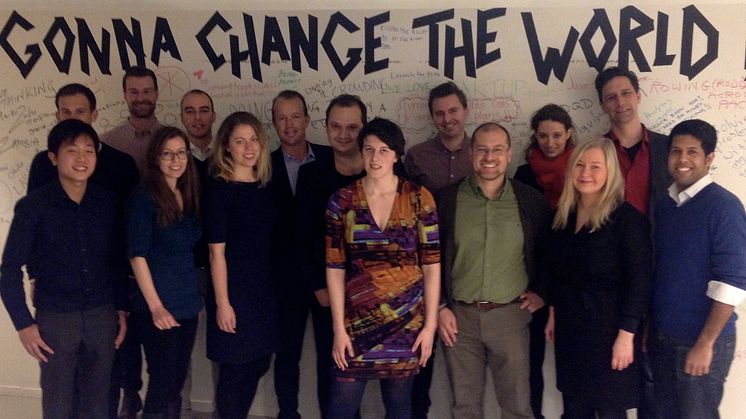
Blog post -
Stockholm Tech – The Startup Boom and the New Face of Venture Capital (Part 4 of 4)
Part 4: The Next VC Wave.
Maybe it’s not a Stockholm syndrome, but a European dilemma. According to a recent article in The Economist about venture capital in Europe, “the rule of thumb is that young American firms raise twice as much money in each round of financing as European ones – and twice as fast.”
“Being in Sweden and far away from the big markets, we should really raise twice the capital here compared to the competitors, not the other way round,” says Pär Hedberg of incubator STING.
US startups, which often are our competitors, usually raise much more than that. About the same time as our software company Qwaya raised $3 million from Swedish investors, a similar company in the social marketing platform category, HootSuite, raised $165 million from US investors. But money isn’t everything, and Nordic companies have to find ways to be smarter and do more with less capital.
In TechCrunch, Mike Butcher underlines that Europe only has 25% of the venture capital available in the United States, coming from about just 25% of the number of VCs – hence the importance of incubators and accelerators like Seedcamp and TechStars. In the European perspective, the Nordic region does quite well. We have 4% of the population, 15% of the venture capital invested and 20% of the return, according to data compiled by VC firm Northzone. This also correlates with a generally high standard of living and global competitiveness in the Nordic countries. But the fact remains: US invested $36 billions in venture capital in 2013, compared to $9 billion in EU, according to data from PitchBook.
Although there should always be a healthy level of venture capital and we can debate whether the VC market is the right size or not, the Swedish market could probably swallow an additional 2 to 3 billion SEK ($300-500 million) for early stage and expansion capital, representing two to three new mid-size VC funds. This could also create more diversified portfolio opportunities for limited partners. “It would be good for the market with more VC funds here,” says Hans Otterling, general partner at Northzone.
Where is the government in all this? Besides the current programmes, many believe that the Swedish state could play a much bigger role in the venture capital market. A governmental limited partner fund of 2 to 3 billion SEK, like Norway’s Argentum (about 10 billion NOK), that can invest in Swedish VC funds would fuel the venture market. Actually, Norway’s Argentum seems willing to enter cooperation with the Swedish state to set up such a limited partner fund of funds. I met Argentum’s head of business development this summer, and they confirmed this possibility. Already, in another sector, the popular TV show Skavlan is a successful Norwegian-Swedish co-production. However, it does not look like it’s going to happen in VC. But the Swedish government is now actually launching a new fund-in-fund to invest in VC funds, financed partly by EU, but it is only 420 million SEK (about $60 million) and will probably be managed by the European Investment Fund (EIF) in Luxembourg, far away from Stockholm.
To the government’s credit, a new initiative launched 1 December 2013, “Investeraravdraget”, tax incentives for individual investments in small companies. Like in the US with the new JOBS Act and the UK’s long-established Enterprise Investment Schemes (EIS), the public might become a new source of venture capital. But Sweden is nowhere near the successful, tax-efficient Venture Capital Trusts (VCTs) that have fueled UK startups with venture capital.
According to Staffan Helgesson at VC firm Creandum, the whole eco-system is the solution. A healthy structure of VC and angels, universities and service providers, limited partners that invest in ventures, the established corporations, new incubators and accelerators – and a favourable legal and tax framework – all working together to support entrepreneurs and startups. One missing piece today is tax rules that support startups. For example, stock options are expensive and fully taxed like wages.
Not caring too much about the political framework, entrepreneurs do as they have always done – they go ahead regardless. And we do have the most important part of the eco-system in place; experienced entrepreneurs and the booming startup market. That market will attract more capital. In summary, the future for the Swedish (and European) VC market looks quite promising. But the next VC wave will be different from before, and the pool of capital is likely to come from many sources. The new face of VC is fresh, sparkling and international.
- We will see more international VCs, and accelerators too, in Sweden
- Cash from new, major exits is likely to be re-injected into the market
- Individual capital investments will grow with new tax schemes
- Crowdfunding is now an established part of the seed market
- New limited partner fund-of-funds for venture capital from the state
- More new VC funds (small and big), and LP investments
- Angel and family office activity continue to grow steadily
- Accelerators and “startup experiments” will increase in Europe
- Driven by the need for innovation, there will be more corporate VC
- New databases like Mattermark will make dealflow completely public
- Increased competition will force VCs to be more entrepreneur-friendly
- Private Equity (“Buyout”) starts investing in online as cash flow grows
- Society’s digital transformation will attract increasing flows of capital
- Startups, consumers, talents and venture capital become truly global
Where is Sweden and Stockholm in all this? Creating innovations and taking them international is in our Swedish genes, from Nobel, Ericsson, Volvo, Electrolux, SKF, Tetra Pak and Atlas-Copco to H&M and IKEA. Being a small open economy, we have always relied on foreign markets and exports for our wealth.
Now global infrastructures are quite different; Google AdWords for marketing, Facebook for distribution, Android and App Store for sales, and LinkedIn for networking. Companies like King.com (games) and Spotify (music) have all learned to master these new channels. Swedes are not the best sales people in general, but we make great products and new startups are learning to spread them across the globe in new smart ways.
While Sweden is a member of the EU, startups here really don’t rely on connections in Brussels, but rather whom we know in Silicon Valley and Seoul. The first overseas office for a Swedish startup is usually London, New York or San Francisco.
Combine our global mindset, the collective know-how of a growing number of combat-experienced entrepreneurs, world-class education and engineers, the highest smartphone and broadband usage in the world (making a perfect test market of early adopters), our mobile DNA, the dynamics of a booming and international metropolitan area… Just add more venture capital to boost the hundreds of promising startups, and Stockholm is easily one of the most exciting tech hot spots in the world today. Welcome to #sthlmtech.
Originally published on Standout Capital.
(Image courtesy of FundedbyMe)
